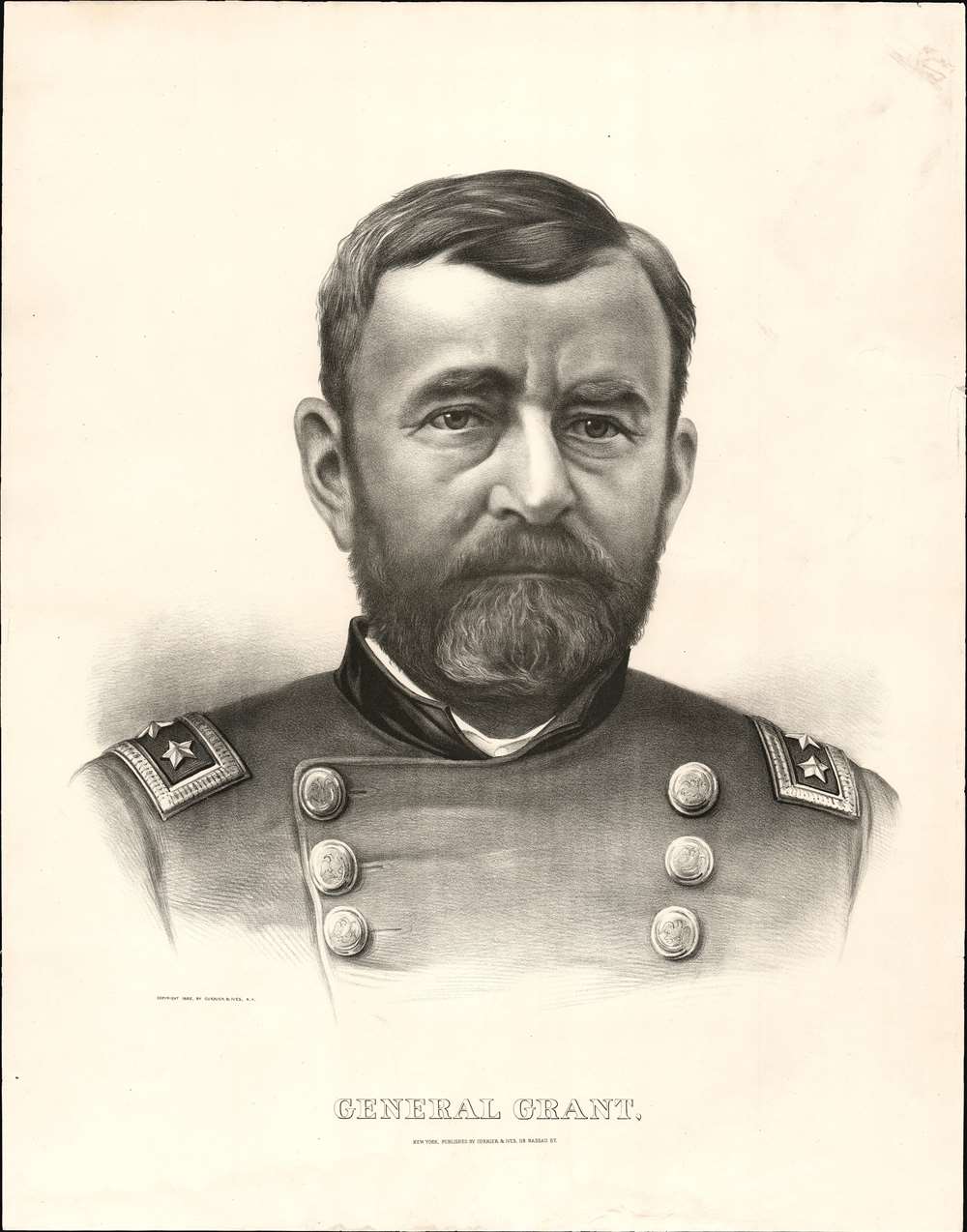This item has been sold, but you can get on the Waitlist to be notified if another example becomes available, or purchase a digital scan.
1885 Large Format Currier and Ives Portrait of Ulysses S. Grant
GeneralGrant-currierives-1885
Title
1885 (dated) 27.75 x 22 in (70.485 x 55.88 cm)
Description
Grant: The General
Ulysses S. Grant (April 27, 1822 – July 23, 1885) was one of the most influential figures an American military history. He was born in Point Pleasant Ohio, the son of a tanner and merchant. After attending the U.S. Military Academy at West Point, he went on to serve with distinction as a Quartermaster in the Mexican American War (1846 -1848). He resigned his commission in 1854, but after a brief stint back at the leather shop, Grant re-enlisted as a Major to fight the American Civil War (1861 - 1865). He rose quickly through the ranks, being promoted to Colonel, then Brigadier General in 1861. In 1864, following several major victories, Grant was promoted to a 3-star Lieutenant General, only George Washington had held this rank previously. Firmly in command of Union Forces, Grant was able to turn the tide of the war. Early in the Civil War, the patrician southern General Robert E. Lee's tactical and strategic genius led to numerous Confederate victories, often against superior, better equipped Union forces. Grant, who rose through his early ranks as a quartermaster, understood supply lines and 'the big picture'. Unlike Lee and earlier Union commanders, he oversaw the entire as a whole and recognized the Union manufacturing superiority and supply lines as the deciding factor. With dogged determination, Grant pursued Confederate forces throughout the south, often with heavy losses, ultimately accepting Lee's surrender at Appomattox Court House. Following the War, Grant was generally worshiped as the hero who save the Union. His service as a general, reflected here, is often overshadowed by a presidency criticized (fairly or unfairly) for scandal and corruption.Publication History and Census
This portrait was published by Currier and Ives in 1885. The lithograph exists in two states. The example in the collections of the Library of Congress, has the copyright statement at center, whereas on the present example it is situated on the left. It is not clear which variant has primacy. While widely reproduced from the Library of Congress example, there are only two known surviving originals - the present example and the LOC example.CartographerS
Nathaniel Currier (March 27, 1813 - November 20, 1888) was an American lithographer best known as part of 'Currier and Ives'. Born in Roxbury, Massachusetts, Currier attended public schools until fifteen, when he apprenticed with the Boston lithographic firm of William and John Pendleton. The Pendletons were the first successful lithographers in the United States and were responsible for educating the next generation of lithographic printers. In 1833, Currier left the Pendleton's shop to work with M.E.D. Brown in Philadelphia. A year later, Currier moved to New York City, where he planned to start a business with John Pendleton. When Pendleton backed out, Currier found a new partner, founding 'Currier and Stodart', but the concern survived for just a year. Currier opened his own lithographic studio in 1835 as an eponymous sole-proprietorship. He initially printed the standard materials, including letterheads, sheet music, and handbills. Later in 1835, Currier began issuing current event imagery. Some of his news printers were issued in the New York Sun. By 1840, Currier had moved away from 'job printing' and further toward fine-print publishing. His Awful Conflagration of the Steam Boat 'Lexington', was published in the Sun that year, as well as being separately issued. James Ives (March 5, 1824 - January 3, 1895) began working under Currier in 1850 as a bookkeeper. Ives contributed greatly to the growth of the business, particularly as a manager, marketer, and businessman. Ives became a full partner in 1857, and the firm was renamed 'Currier and Ives'. Currier and Ives produced over 7,500 images and is best remembered for its popular art prints, particularly Christmas scenes and landscapes. They also produced banners, illustrations of current events, views, and historical scenes. Currier retired in 1880 and turned the business over to his son Edward. Currier married Eliza West Farnsworth in 1840, with whom he had one child Edward West Currier. Eliza died in 1843. Currier remarried to Lura Ormsbee in 1847. Other than being a lithographer, Currier also served as a volunteer New York City fireman during the 1850s, and he liked fast horses. More by this mapmaker...
James Merritt Ives (March 5, 1824 - January 3, 1895) was an American businessman, bookkeeper, and lithographer who oversaw the business side of the famed lithographic firm Currier and Ives. Born in New York City, Ives was a self-trained artist who began working at the age of twelve. He married Caroline Clark (1827 - 1896) on June 24, 1846, who was the sister-in-law of Nathaniel Currier's brother, Charles Currier. In 1852, Nathaniel Currier (March 27, 1813 - November 20, 1888) hired Ives as the bookkeeper for his firm N. Currier, Lithographer, on Charles's recommendation. Ives' talent for art and his knowledge of the artistic world soon became apparent to Currier, who valued his insights as well as the business acumen. Currier offered Ives a full partnership in 1857. They renamed the firm 'Currier and Ives' with Ives as the general manager. Ives began to play a role in selecting artists and prints to publish, and was responsible for pursuing publication of scenes of middle-class America that made the firm famous. After Ives died in 1895, his sons continued to work with Currier's son to manage the firm until it was liquidated in 1907. Learn More...

